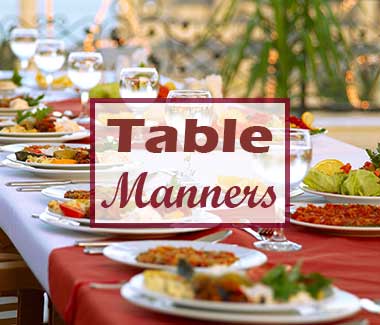India Etiquette
Dining etiquette for dining with Muslims and Hindus. Islam prohibits the use of pork, and Hindus do not eat beef.
- When dining with Hindus, do not touch directly any food that is being served to others, and this is especially the case between men and women: this makes it impure.
- When dining with devout Muslims, it is especially important for women not to touch directly any food that is being served to men: this also makes it impure.
Dining etiquette for drinking. Because you must never pour your own drink, always be alert throughout the meal as to whether your neighbor's cup or glass needs refilling. If it is less than half full, it needs refilling. If yours is less than half full, your neighbor is obliged to refill it. If he or she does not, do not refill it yourself, instead, pour a little more drink into your neighbor's glass, even if it doesn't really need it.
Dining etiquette for making a toast. If you are the honored guest, you will be expected to make a toast, usually soon after the host does or at the end of the meal. An appropriate toast is to the health of the host and all those present, and to the prosperity of the business under discussion.
Dining etiquette for eating with utensils. Since the spoon is more important than the fork, if you are right-handed, keep the spoon in your right hand, and put it down to switch to the fork if you need it. Never use your left hand for eating.
Dining etiquette for eating with your hands. Wash your hands before you sit down to eat. You will also need to wash your hands again at the end of the meal. Use your right hand when picking up and eating food, never your left hand. Keep your left hand at your side. Do not place your left hand on the table, and do not pass food with your left hand. Banana-leaf food is eaten with your hands. These are vegetarian or meat curries, served with rice and sauce on a large banana leaf. Reach into the rice, take some with your fingers, gently roll it between your index and middle fingers and thumb (not in your palms!) into a kind of self-sticking ball, dip it into the sauce on the banana leaf, mix it with a vegetable or a piece of chicken, then pop the whole thing in your mouth. Most of these hands-on banana-leaf restaurants are Muslim or vegan (Hindu).
Dining etiquette for eating in restaurants:
- Men and women may be asked to dine separately.
- If you cannot eat without some kind of utensil, it's usually all right to ask for one.
Dining etiquette for smoking. Do not smoke until the meal is over.
Dining etiquette for seating. The host sits at the head of the table, with the honored guest seated next to the host. (Spouses are usually not invited to business meals in restaurants. Do not ask if your spouse can join you: it will embarrass your Indian colleague into doing something that is uncomfortable for him; however, your spouse might be invited to a meal at your colleague's home, especially if the spouse of the host will be there, which will probably be the case.) In addition, the honored guest sits on the side of the table farthest from the door. (In business meetings, the key people sit in the middle, flanked on either side in descending order by their aides, with the least important people sitting at the ends of the table farthest from the middle, and closest to the door; the arrangement is mirrored on the other side.) Men and women eating at someone's home may dine in separate areas (and spend the entire evening separated) or at separate times, with the men dining first.
Dining etiquette for serving. The honored guest is served first, then the oldest man, then the rest of the men, then children, and finally women.
Dining etiquette for beginning to eat. Do not begin to eat or drink until the oldest man at the table has been served and has begun.
Dining etiquette for the meal's end. At the end of the meal, it is considered unnecessary and in bad taste to thank the host or hostess for the meal; this is perceived as a "payment" for the meal, and as a guest, you should not do that. Instead of thanking the host vocally when you are finished, just perform a namaste at your seat.
Dining etiquette for discussing business. Business meals are generally not good times to discuss business or make business decisions, however, take your cue from your Indian associates: if they bring up business, then it's okay to discuss it, but wait to take your lead from their conversation.
Dining etiquette for Indian homes. When invited to a colleague's home for a formal meal, you will be told where to sit, and there you should remain. It is a great honor to be invited into an Indian home. Once inside, you may need to remove your shoes.
Dining etiquette for tipping. Tipping is universally required, everywhere you can imagine-and then some. Tips in restaurants run about 10 percent.



